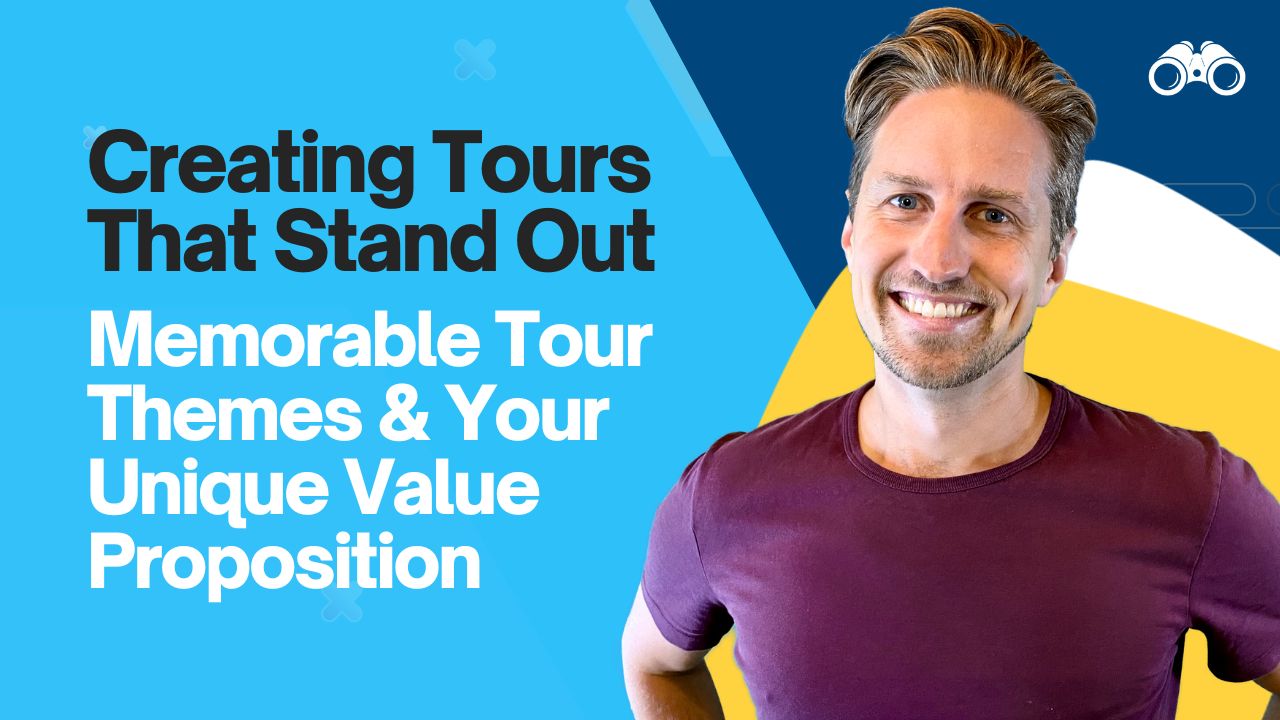Creating Tours that Stand Out: Memorable Tour Themes and Your Unique Value Proposition
This is the fifth of a 10-part series on tour design. Start with part 1 here.
A plague doctor leads visitors through Prague’s darkened streets, recreating life during the Black Death. In Portland, coffee enthusiasts pay premium prices to go behind the scenes with master roasters. While other operators compete on price, these tours sell themselves because they’ve mastered one essential element: a powerful theme.
A tour theme is more than a catchy tagline—it’s a clear subject or topic explored throughout your experience. When done right, it should be simple enough to express in a single sentence and answer the question: “Why are we learning about this particular topic today?”
Your theme serves as a natural filter, giving you clear guidelines for what content and stories to include, which stops to make, and what activities will contribute to the overall experience.
Four Types of Tour Themes That Create Memorable Experiences
Theme as Objective
Gourmet Madrid Tours promises something specific: “Get a crash course in Spanish cuisine by tasting all Madrid’s star dishes in just one afternoon.” Notice the clarity—not just “see Madrid” or “taste Spanish food,” but a complete culinary education in one morning. The Berlin Street Art Workshop takes a similar approach, promising that “by the end of the tour, you’ll design and create your own piece of street art while discovering the city’s urban art scene.”
This objective-based approach is particularly powerful because it naturally sets up a sense of accomplishment. When guests complete your tour, they’ve achieved something tangible—whether it’s comprehensive knowledge of local cuisine or their own piece of street art. This satisfaction becomes a crucial part of the experience itself.
Theme as Focus
New Zealand’s Lord of the Rings tours made a bold choice: they excluded traditional highlights, history, and natural wonders to focus entirely on one passionate audience. By going deep rather than broad, they’ve become the obvious choice for their niche. This laser focus allows them to command premium prices and attract enthusiast groups from around the world.
Portland’s coffee culture tour exemplifies this approach by bypassing general city highlights to focus solely on coffee culture. They’ve recognized that coffee isn’t just a beverage in Portland—it’s a lens through which to understand the city’s character, rituals, and values. This deeper perspective helps justify premium pricing while attracting both coffee enthusiasts and culturally curious travelers.
Theme as Journey
Some journeys are physical, like Australia’s Great Ocean Road tour or Maui’s Road to Hana experience. Others are symbolic, like Prague’s plague doctor experience that transports guests back to the 17th century. The most powerful tours often combine both.
Consider a bicycle wine tour in Burgundy, France. The day begins at an 800-year-old Cistercian monastery, where ancient wine presses tell the story of early winemaking. As cyclists move through the countryside, they learn about Napoleonic inheritance laws that created the patchwork of family-owned vineyards. The journey concludes at a modern winery, where stainless steel technology represents contemporary winemaking. This tour succeeds by combining a physical bicycle journey with a symbolic journey through time, creating a rich narrative about the evolution of Burgundian wine.
Theme as Story
London’s Karl Marx tour doesn’t just show places—it walks you through one person’s life story, using locations to serve the narrative rather than the other way around. Similarly, Hemingway’s Paris tour follows the transformation of an unknown journalist into a literary legend through the cafes and streets of 1920s Paris.
The key to story-based themes is understanding that every great story needs one big question that’s only resolved at the end. This question should arise from a main character experiencing conflict, tension, and unmet desire. Each stop on your tour should contribute to the rising action, adding tension and raising stakes until the final resolution.
When using story as your theme, ground it in a specific individual rather than trying to tell the story of an entire city or neighborhood. While it’s tempting to say you’re “telling the story of Little Italy” or “revealing the story of Hong Kong,” these broad approaches often fall flat. Instead, focus on a specific character—whether it’s a historical figure like Hemingway, a modern-day local, or even a representative person from a particular time period. Let their personal story illuminate the larger narrative of your destination.
Creating Your Tour Theme
A strong theme naturally creates a unique value proposition. It tells potential guests exactly what makes your tour special, who it’s perfect for, and why they should choose your experience over alternatives. Most importantly, it helps you design experiences that leave guests with that satisfying sense of completion—whether they’ve mastered Spanish cuisine, traced a writer’s journey to greatness, or traveled through time with a plague doctor as their guide.
The strongest themes aren’t about trying to include everything—they’re about making intentional choices about what to include and what to leave out. Your theme becomes a powerful tool for both tour design and marketing, helping you create and sell experiences that stand out in a meaningful way. By focusing your tour through the lens of a clear theme, you create experiences that resonate more deeply and command higher prices, simply because they deliver exactly what they promise.
Remember, your theme should be expressible in one clear sentence. This clarity not only guides your tour design but also makes marketing and selling your experience more effective. When done well, a strong theme helps differentiate your offering, justify premium pricing, and create that crucial sense of satisfaction that turns first-time guests into passionate advocates for your tours.




